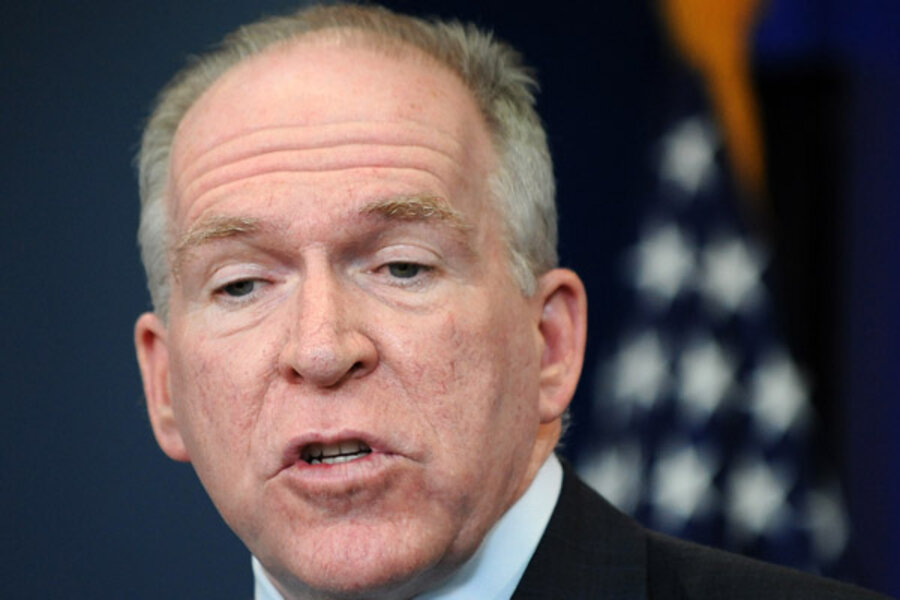US unveils new counterterrorism strategy: three key parts
| Washington
The White House unveiled a new counterterrorism strategy Wednesday that homes in on what it says is a declining but still dangerous Al Qaeda – and that for the first time makes a priority of the threat posed by adherents of Al Qaeda’s extremist ideology inside the US.
“This is the first counterterrorism strategy that focuses on the ability of Al Qaeda and its networks to inspire people in the United States to attack us from within,” said John Brennan, President Obama’s chief counterterrorism adviser, in a speech Wednesday in Washington.
The new counterterrorism strategy replaces one from 2006 and calls for pursuing with what Mr. Brennan called “laser focus” the approach that the Obama administration has already been taking. This approach, which the administration says has decimated Al Qaeda’s power, reach, and appeal, includes the following components:
• A zeroing in on the organization’s senior leaders.
• Enhanced cooperation with allies and partners to defeat the extremist scourge.
• A sustained effort to restore America’s image and leadership in the world.
Elaborating on each of these points, Brennan said that, first of all, Al Qaeda’s leadership ranks have been seriously depleted and its recruiting abilities weakened.
“All told, over the past 2-1/2 years, virtually every major Al Qaeda affiliate has lost its key leader or operational commander,” he said – adding that the operation in May resulting in the death of Osama bin Laden was “our biggest blow against Al Qaeda yet.”
Second, he said, the US will continue to deepen the kind of intelligence cooperation that was exemplified by Saudi Arabia’s tip-off to US intelligence officials last October about explosive devices, which Al Qaeda in the Arabian Peninsula had managed to introduce to planes headed for the US.
Brennan, who at one point in a long CIA career was station chief in Saudi Arabia, said in a question-and-answer session following his speech that the Saudi kingdom was now “one of the best counterterrorism partners that the US has.”
He said he hoped Pakistan – which he described as “one of our most vital counterterrorism partners” – will one day realize, as Saudi Arabia did after a series of internal attacks in 2003, that “this really is a war” that threatens more than US interests.
Third, Brennan said, efforts under Mr. Obama to improve America’s image abroad and enhance diplomatic and people-to-people relations were yielding results – even as Al Qaeda’s image and appeal among Muslims are waning.
He cited the Arab Spring, which he said has “left Al Qaeda and its ilk on the sidelines.” For decades, terrorist groups like Al Qaeda “have preached that the only way to effect change is through violence,” Brennan said, adding, “Now that claim has been thoroughly repudiated, and it has been repudiated by ordinary citizens, in Tunisia and Egypt and beyond.”
As upbeat as those words were, the White House counterterrorism chief sounded a cautious note in emphasizing that Al Qaeda still has an ability to attract adherents.
The new strategy will focus on such adherents inside the US, whom Brennan described as “individuals, sometimes with little or no direct physical contact with Al Qaeda, who have succumbed to its hateful ideology.”
Among the examples Brennan gave was the November 2009 Fort Hood shooting rampage, allegedly carried out by an Army major shouting “God is great” in Arabic.
A key component of Obama’s counterterrorism strategy will be a renewed emphasis on building “strong partnerships between government and communities here at home, including Muslim and Arab-American” communities, said Brennan, who chose Johns Hopkins School of Advanced International Studies to make his remarks.
Announcing the administration’s intention to introduce a new “partnering” effort, Brennan said, “A key tenet of this approach is that when it comes to protecting our country, Muslim-Americans are not part of the problem; they’re part of the solution.”
In another bit of news, Brennan said the new strategy marks the official end of the government using the term “global war on terror.” In his speech, he said defeating Al Qaeda “does not require a global war, but it does require a focus on specific regions,” from South Asia to Yemen and Somalia and the Maghreb.
Later, the counterterrorism chief corrected a student’s phrasing of a question, saying, “We intentionally do not use ‘global war on terror’: We’re in a war with Al Qaeda.”





